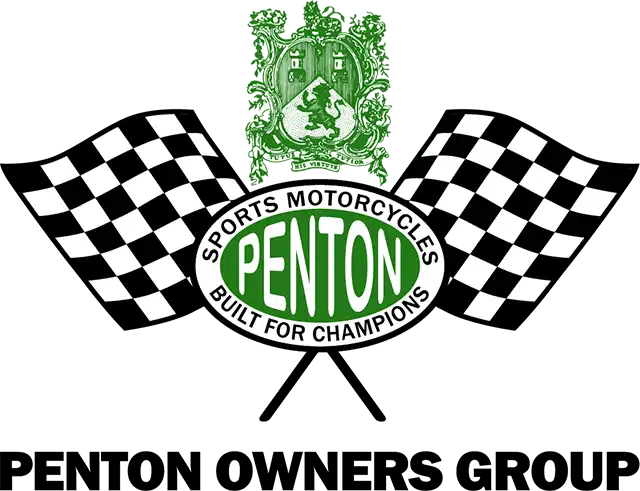Larry Maiers
Photos provided by Larry Maiers
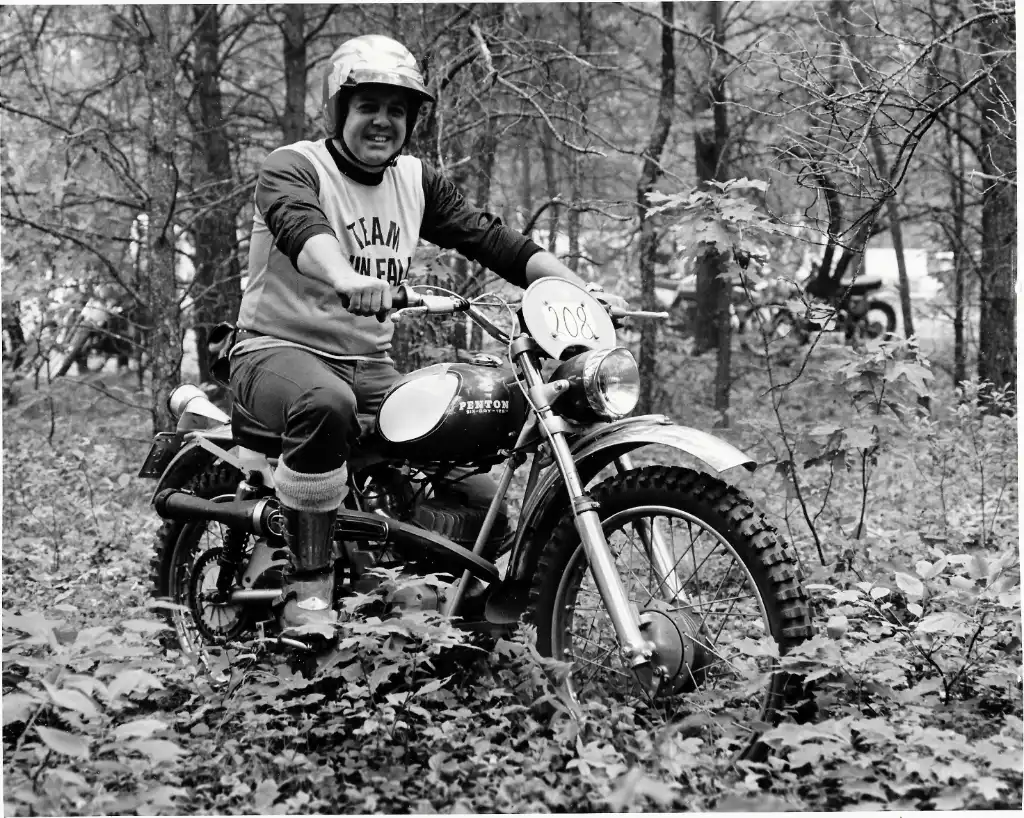
My first interest in motorcycles was the result of being in the right place at the right time. I grew up in Lansing Michigan, home of the famed Jack Pine Enduro. And that was a big deal. When the Jack Piners pulled into town, it was a signal for me and the guys I hung around with to ride our bicycles to Oscar Lenz’s Harley-Davidson shop and watch all the riders as they checked in for the start of the race. The day of the race we’d watch them leave town then watch again the next day when they returned. Bench racing was probably bigger then than it is today so naturally we got as close as we could to the riders and listened to their tales of mud holes, deep sandy trails, wide rivers and thick woods. When it was all over we would tape and tie various tools to our bikes, and pretend we were Jack Piners. Needless to say that led to a lot of lost tools and angry fathers.
My first ride on a real motorcycle was with an uncle who had a 650cc Triumph. I think it took just one ride and I was hooked. I bought a used Zundapp and with a little help from the College Bike Shop, my dream of becoming a champion racer was underway.
It didn’t take long for me to figure out that my inability to ride fast would be a career downfall. So instead of becoming a champion, I became just another participant. That was OK because I was not alone.
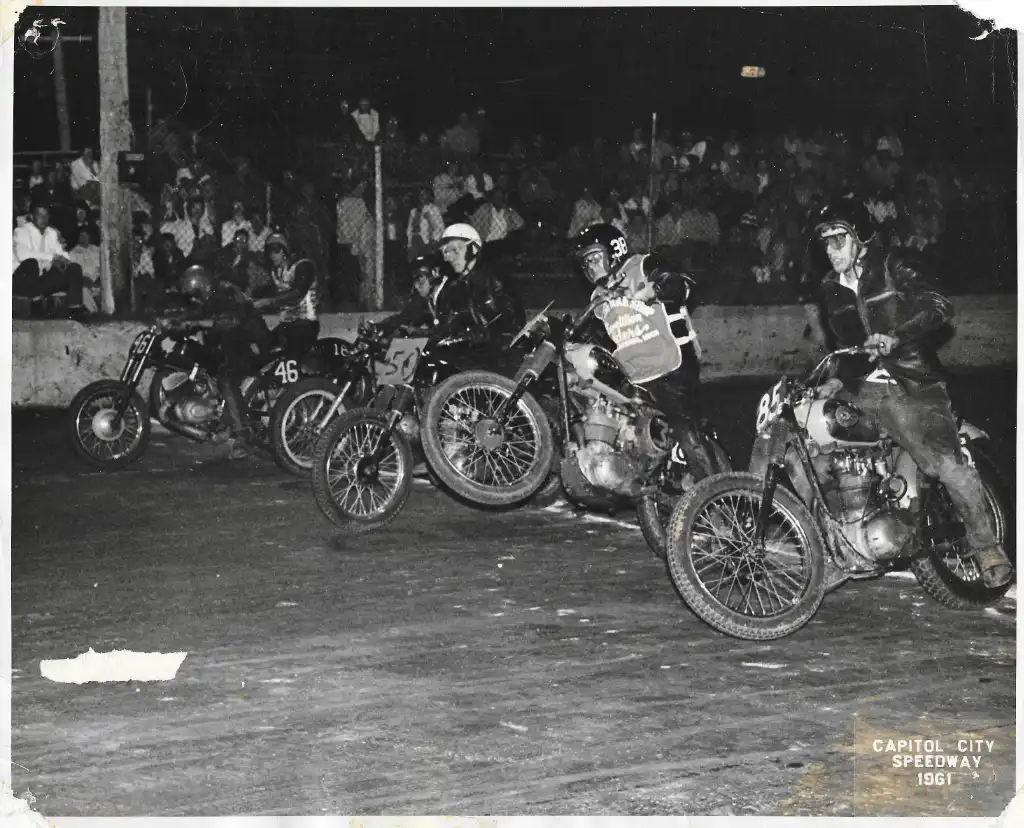
Of course there were the fast guys who at the time were two-wheeled gods. They collected the trophies while most of us made excuses.
Grand National Champion Bart Markel from near by Flint, gave me advice once. It was at a short track. I think he saw me ride, and felt sorry for me. He said run it into the corner until the rear wheel breaks loose and starts to slide. When that happens, blip the throttle and steer with the rear end. I thought about that for a while, decided it made no sense at all, and if I did what Bart said I was sure I’d hit the track ass-end first. Right then and there I decided enduros and scrambles were more fun than short tracks anyhow, so I tended to stay away from the ovals and the fast guys and their advice.
Back in the late 50's, early 60's, winning was not as important as having fun. And there were a lot of us that rode because of just that. It was fun. The camaraderie was off the chart. Someone would always stop and offer help if your bike quit while out on the trail. Afterwards we’d all get together, drink a beer or two, and tell lies about how fast we were.
If you lived in that era chances are you know what I mean. Getting to the event, hanging out, borrowing, or lending a left- behind part or piece of equipment, a ride through the woods, and afterwards waiting to see who got trophies, was enough. It was the best possible way to spend a Sunday.
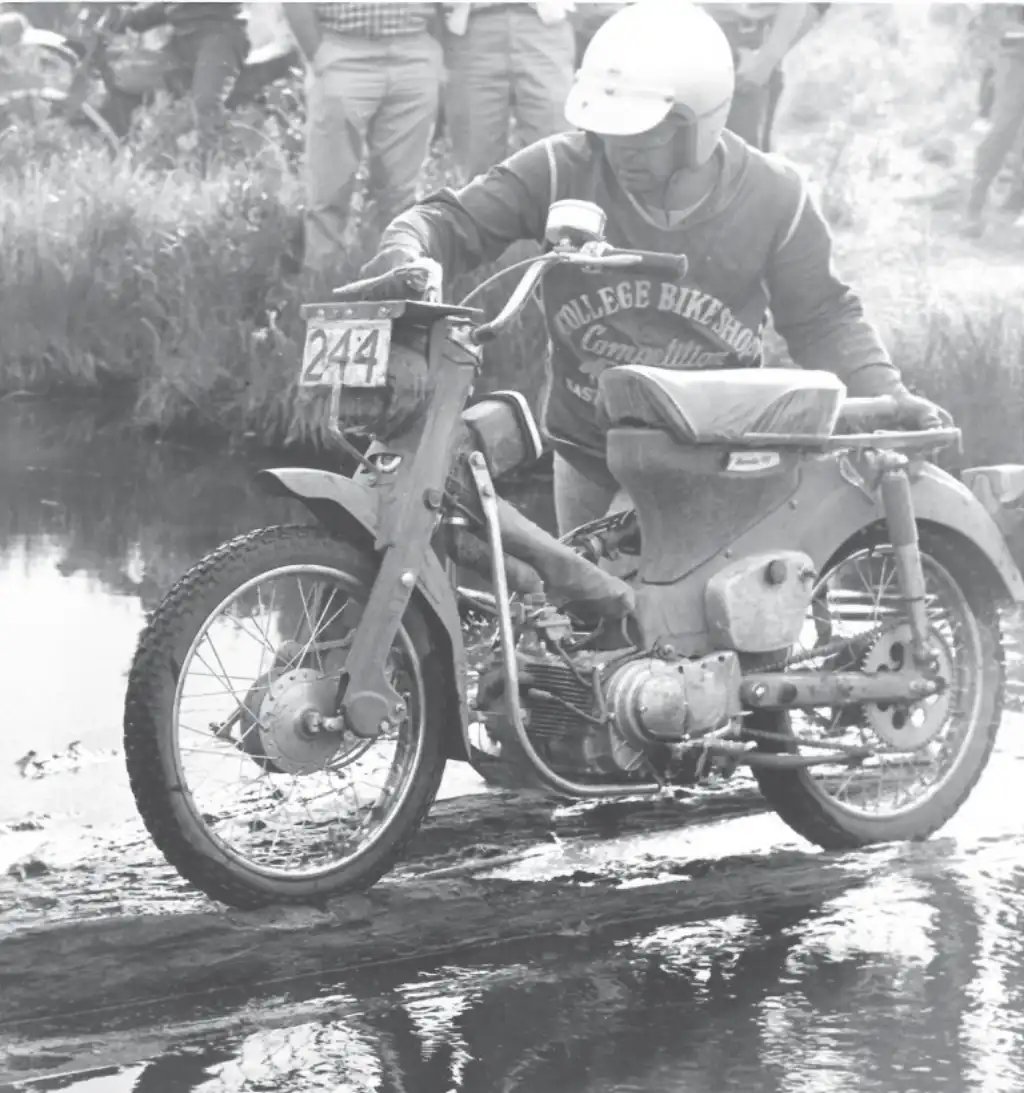
I do have one regret regarding not trying harder. I never won a Jack Pine trophy. It seems like I missed every year by just a few points. One year, I think it was 1964, I rode the 500 miler on a Honda Trail 90. I have no idea what possessed me to do it. I guess it was one of those things that seemed like a good idea at the time and it fell into the category of having fun. The fun stopped when I hit the first mud hole. By the time I got there all I could see were bikes watered out or stuck all over the place. As it turned out I was saved by a big floating log. I was able to wheel that little Honda on to the log, then idle it along the log while wading beside it. I passed a lot of riders that were stuck but in the end it didn’t matter As I recall there were only four or five 90cc bikes entered. I rode the entire 500 miles but so did two other guys. They got trophies and I got zip. It was not a total loss however. Vaughn Vandecar, owner of the College Bike Shop was so impressed that I had finished the run, he tore up my parts bill. Since I was always broke that meant a lot, but looking back, I'd rather have had a trophy.
To support my racing habit I worked for Massey Ferguson as a rep in their construction machinery division. My territory included Amherst, Ohio and John Penton's Motorcycle shop. Naturally Penton Honda became a regular stop on my schedule. At that time, it was late 1967, I was riding a Honda SL 90 and had decided to get a bigger bike and mentioned that to John during one of my visits.
John said if I could wait a few months he would have something for me. He explained he was working with a factory in Austria that had agreed to build a few off road bikes to his specifications. Again, I was at the right place at the right time and said “sure I can wait.”
The first Pentons showed up just a few weeks, or days, I don’t remember exactly, but it was just before the 1968 Stone Mountain Enduro in Georgia. Serial number V0002 was mine. When I took it home I was the proudest old kid in my neighborhood.
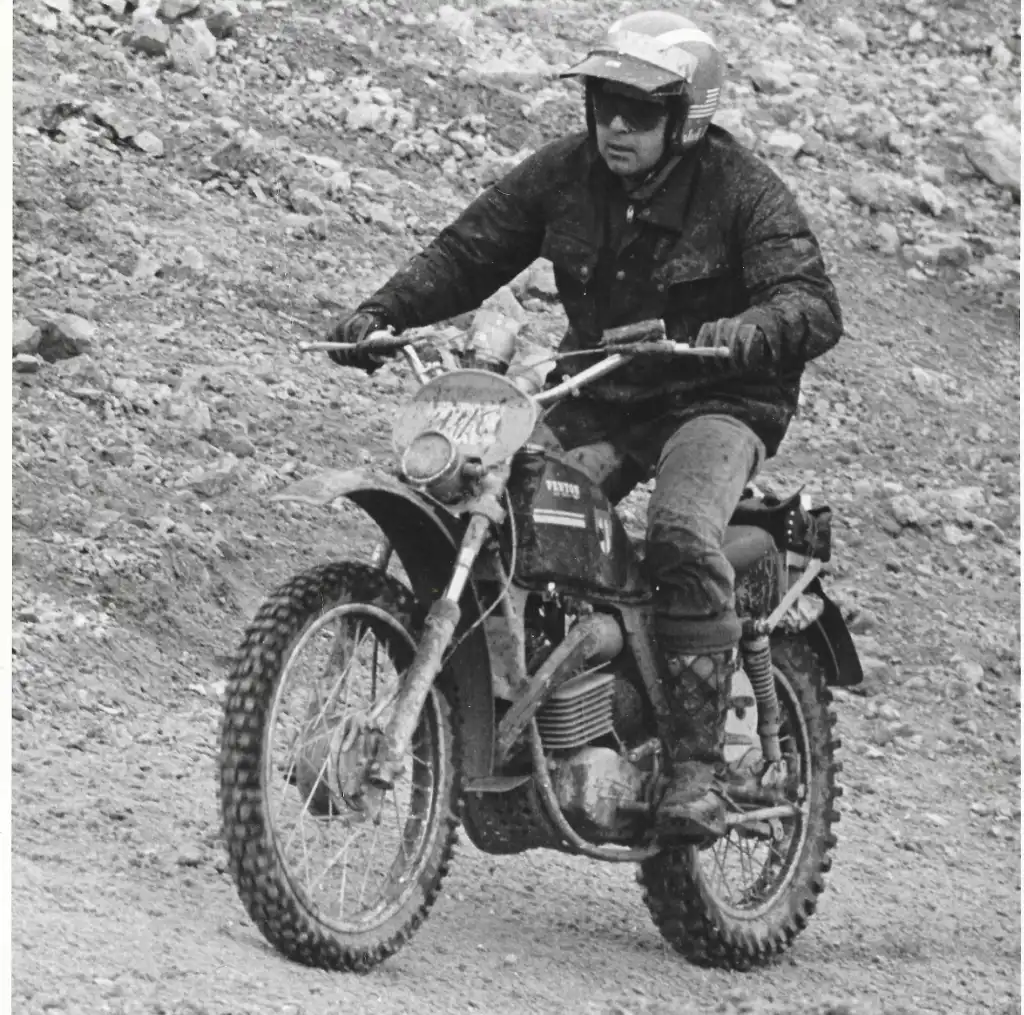
My first Penton ride was a fiasco. I had coated the air box with grease thinking if any sand got into the box the grease would keep it from the carburetor. Then I reasoned if a little grease was good, a lot of grease was better. No sand made it to the carb, but a lot of the grease did. I barely finished within my hour of grace.
Then it was on to Daytona and the Alligator. If Stone Mountain was a fiasco, The Gator was a total disaster. Somewhere out on the trail John caught and passed me. I decided I was going to give that brand new Penton the kind of ride it deserved and immediately started riding way over my head.
We were on a two track going far faster than I was capable of. Going into a corner we caught a slower rider. John went by him on the inside with me close behind. I tried to shave a couple of feet off the corner and hit either a stump or a ditch that was hidden by the weeds. My brand new Penton came to an abrupt stop while I continued on down the trail at a high rate of speed. From that point the next couple of hours were a bit on the hazy side. I remember a rider stopping to help me. He started my bike, and put me on it. I found a road and made it to the finish line. An operation to remove the cartilage from my knee ended my motorcycle (not so illustrious) racing career. I still rode, but caution was the name of my riding style.
In case you were wondering, the answer is yes. I know where my first Penton, serial number V002 is. Dallas York, former owner of Twin Falls Cycle, took it in on trade and still has it.
A couple of years later I was again at the right place at the right time. John told me his business was growing in several directions and he needed a little help. Would I be interested? A no brainer if I ever heard one. At the time I was living in DesMoines, Iowa with my wife, DiAnn, and two sons, Bret, and recently born Jay. I had a pretty decent job as National Sales Manager of the Massey Ferguson Lawn and Garden Division. I went home and told my wife what I was doing and she said, “You’re doing what?” It was a pretty big leap of faith, but I loved the sport and it was something I was really excited about.
I worked at Penton Imports from 1972 until 1985. If you want the company history and progression during that period of time, you’ll find it in the book “JOHN PENTON AND THE OFF-ROAD MOTORCYCLE REVOLUTION”, written by former AMA President, Ed Youngblood. Not recorded in the book are a lot of behind the scenes stories that affected me as well as the company.
I’ll start by telling you the years I spent at Penton Imports/Hi-Point Racing Products were absolutely the greatest. How could they not be. I was surrounded by motorcycles, the best motorcycle racers in the world, loyal and enthusiastic dirt bike dealers, and extremely dedicated fellow employees. For myself, it was the Golden Years of off road riding.
The AMA was just beginning to establish Motocross National Championships. That led to motorcycle manufactures fielding factory Teams. That in turn led to an explosion in the motocross apparel market fueled by newly hired Pro riders. HiPoint Racing Products was on the ground floor, and initiated some of the first rider sponsorship deals in motocross.
One year, I think it was around 1974 or 75, just to say thank you, I bought some Malcolm Smith wallets and put $500 in each and gave them to a few of the top riders who wore our Hi-Point boots: Bob Hannah, Pierre Karsmakers, Marty Smith, and Brad Lackey. Before long we were giving free boots to the top riders in exchange for advertising rights.
I also made deals with a whole lot of Pro riders that were not turning in advertising type results. I sold them boots at slightly over cost with the understanding that they could resell them when they started to break down. With the money they got for the boots, they then would buy new ones. That guranteed the start line would be full of Hi-Point Boots. I should point out that promotions aside, Hi-Point Boots were absolutely the best on the market.
Bob Hannah was probably the first rider to get big sponsorship bucks from the apparel companies. One of the stories I remember about Hannah was that we had a deal in which Hi-Point paid him in gold for his wins. Hannah would watch the gold market, and when he felt the price was right he would call, and I’d have to quickly come up with the money, and buy him gold Krugerrands.
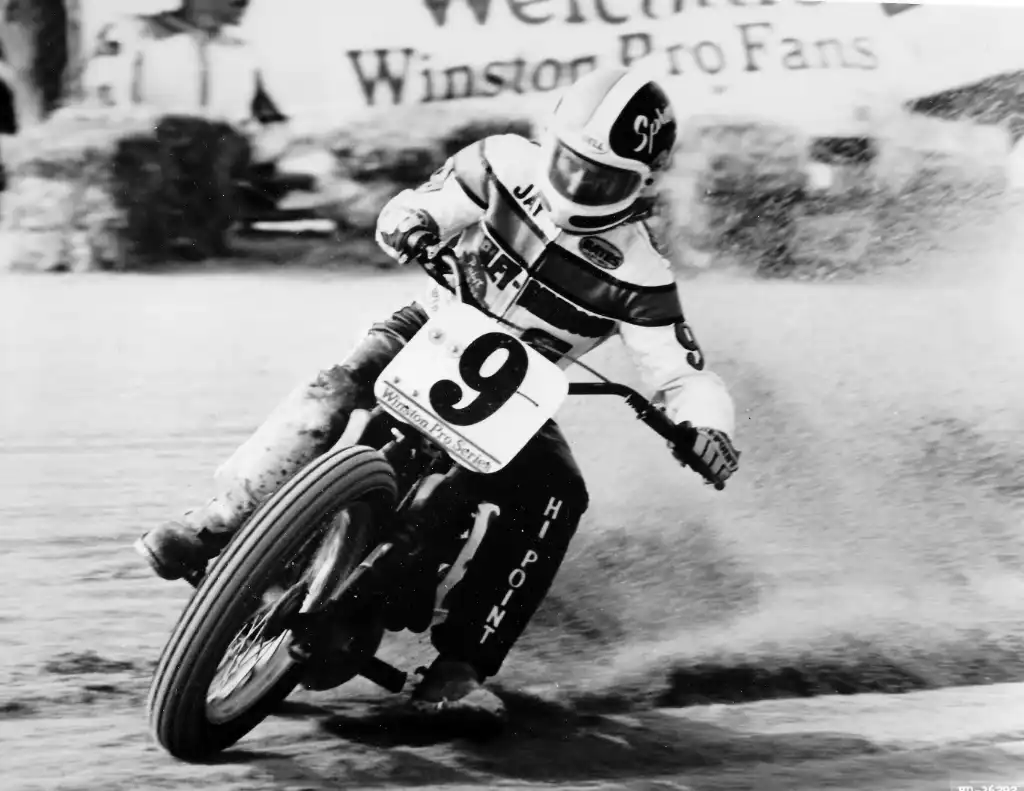
Sometime in the early 70's John purchased a building that was previously a roller skating arena. This, along with additions added by John became the new home of Penton Imports and Hi-Point Racing. One of the additions was a huge garage that housed the Penton fleet of CycleLiners and semis that were used to haul motorcycles and boots to Texas and California. A side benefit was that whenever the motocross circuit was near our part of the world, the mechanics used that garage to rebuild their bikes between races. It was a great PR tool for us. They wouldn’t do that today, but back then mechanics and riders, regardless of team allegiance, got along with each other and used to caravan from race to race. I use the term caravan loosely. More often than not they raced from venue to venue and frequently waged paint ball wars along the way.
That was part of the Golden Era of Dirt Bikes. We all got along and had a great time doing it. I recall prior to one of the Mid Ohio races John arranged for the Amherst Meadowlarks to open their track to the Pros for testing. To entertain the attendees Hi- Point hosted what we called a Corn Cross. Riders, mechanics, and Ohio's finest corn on the cob, with Jammin Jimmy Weinert on the Guitar. How could it get better than that?
Somewhere along the line, the moped craze bit John and we ended up with a warehouse full of KTM/Sachs Mopeds. What I remember most is the government bumbling the market with legislation that I sometimes felt was aimed directly at putting us out of the moped business. We received a government directive one day stating that fuel shut off valves had to be mounted in a specific direction in relation to the fuel tank. Naturally the valves on our mopeds were mounted just the opposite. I recall saying to John, we more than likely would have to change the valves, but what we should do is go to Washington and find out why. I swear there was glint in John’s eye when he said, “Maiers, thats a damned good idea.”
So we loaded a moped in a van and headed for the home of the Nation's law makers. For two days we went from office to office trying to find someone that could, or would, shed a little light regarding how stupid laws were written. Finally we found the guy that authored the fuel valve directory. He didn’t want to see the moped we had brought from Ohio, nor could he explain the need for the valve to be mounted in a certain direction. He had never ridden a moped, but he did assure us that the directive was based on tests that he was not able to put his finger on right at that time nor did he recall what the tests were. He assured us if we waited around for a few days he could come up with answers. Yeah ----- Right.
We left to go back to Ohio. On the way we had to laugh. I think we both knew when we started out that we were on a trip to nowhere and would accomplish nothing. We succeeded beyond our wildest dreams.
One of my Penton /HiPoint proudest memories came from the results of short-lived Penton Short Tracker. It’s a long involved story but here’s the nickle version.
Carl Cranke was involved with the motor and exhaust. Carl knew 100% what he was doing and what kind of power band was needed. Kenny Roberts told me he had a frame production business. He designed and built the frame. Kenny later admitted he knew nothing about building frames but did know how the finished product was supposed to react when it came time to go left. If it did not react the right way he would simply build another frame making this a little longer, that a little shorter, and increase the angle of the dangle. At least that’s the way he explained it to me many years after the fact. Dirt Tracker Mike Kidd was hired to ride it.
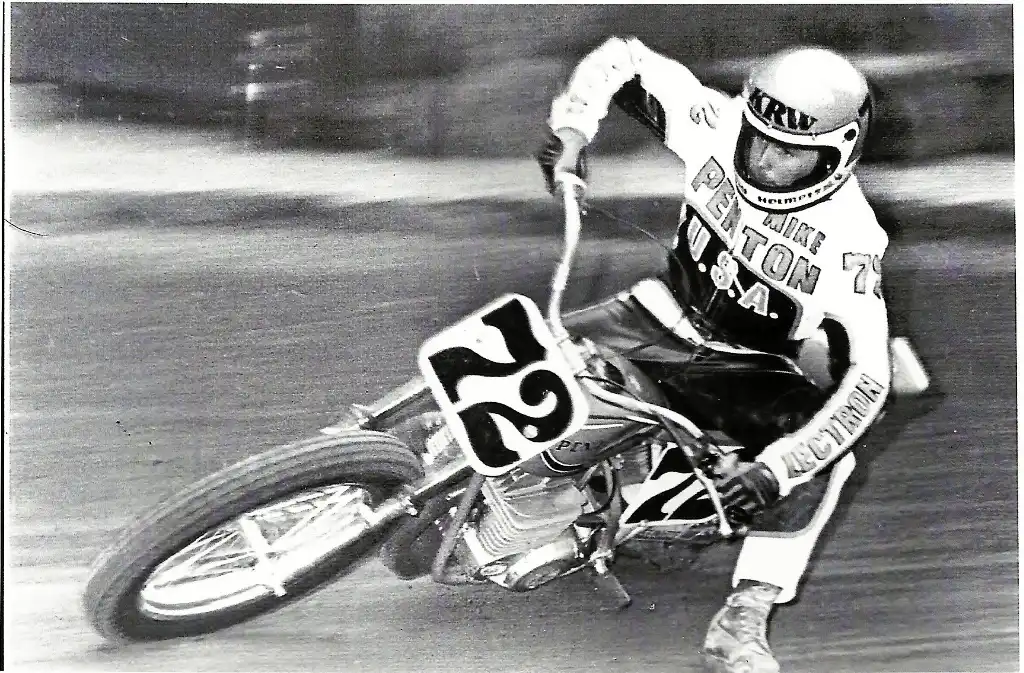
The first outing was the short track national at the Houston Astrodome. During time trials we were holding a Penton dealer meeting. I had asked Mike to come to the meeting and meet the dealers. He said he would try to make it. In the midst of the meeting Mike, dressed in shiny new racing leathers with “PENTON” across the chest, burst into the room. He apologized saying his time trial was not as good as it should have been because he was sick with the flu. He was third. Can you imagine? Against the factory Yamahas, Harleys, Bultacos, Hondas and the rest of the major dollar entries that had been building short trackers for years, Mike was sick and still claimed third fastest time. And he said he was sorry???
Later that night with the race underway, Mike was holding second. He stayed there until near the end when he dropped back to third. On the victory podium I think he said, “not bad for a woods bike.” “If there had been a couple of trees out there we’d have won.” Race results don’t usually bring tears to my eyes but that one did. Unfortunately there was no market for short trackers.
Here’s another story with tears. This one changed the face of American motocross and I’m proud to say I was there all the way and so was Penton Imports in 1981. It started with a discussion between Dick Miller, who was the editor of Dirt Bike Magazine and myself. The topic of the discussion was MotoCross and Trophee Des Nations. Here’s a portion of the story taken from the induction of the 1981 American Team into the AMA Hall of FAME (from their web site):
“For a while, it looked like the United States would not send a team to the competitions, but a group of industry enthusiasts, spearheaded by Hi-Point’s Larry Maiers and Motocross Action Magazine’s Dick Miller, convinced Honda to enter its American motocross team in the des Nations. Honda, its sponsor Bel-Ray Lubricants, along with funding raised through T-shirt and product sales and donations, raised the money necessary to field a team.”
“The team’s arrival in Europe was not a warm one. The “no-name” B-team of Honda riders was scoffed at by des Nations officials as being unworthy of participating in the prestigious des Nations competition. Even the riders themselves came only hoping to do well and salvage a bit of respectability for American motocross.”
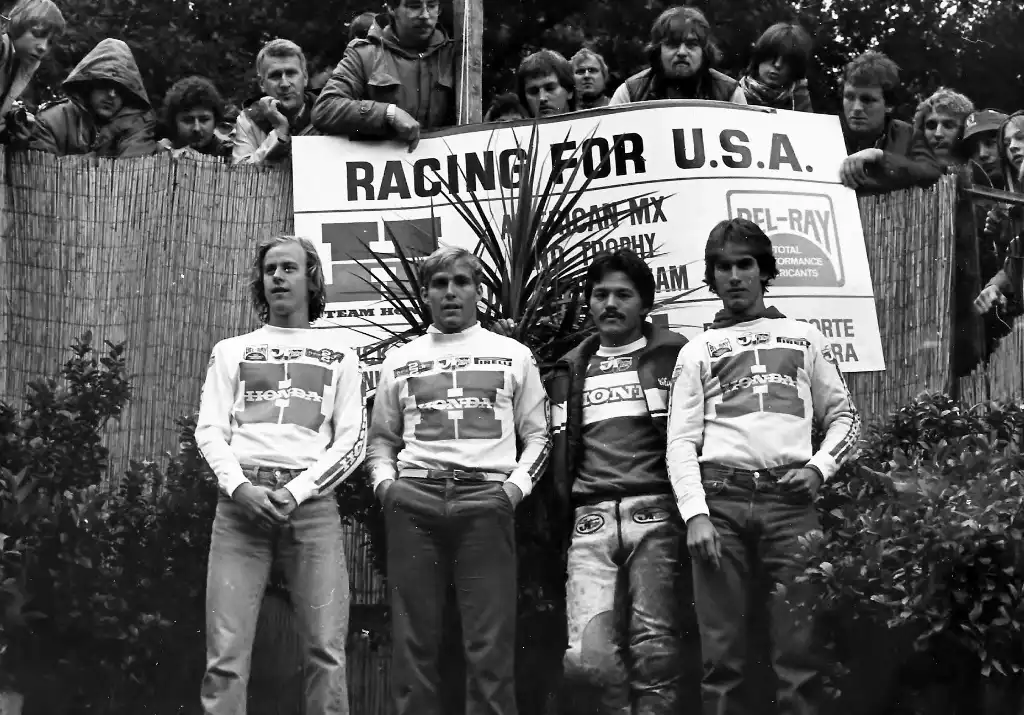
The no name B team consisted of Johnny O’Mara, Donnie Hansen, Chuck Sun, and Danny LaPorte. The team manager was Roger DeCoster. The B team won the Trophee Des Nations in Lommel Belgium. They won the MotoCross Des Nations in Bielstein, W. Germany. If there were questions in the minds of anyone regarding the state of motocross in America, they were answered in 1981.
Here’s a footnote to the story.
After the event John Penton and I were in the hotel lobby when O’Mara and Hansen came through the door. I introduced John to the pair of MX stars. In the process of expressing his congratulations John touched on his efforts to field a winning ISDT Trophy Team and the number of years he had been at it. As he talked, tears of emotion spilled from his eyes as well as mine. Hansen looked at us and said,
“Mr. Penton, you shoulda sent me and Johnny sooner.”
An area of racing that’s always been a favorite of mine is dirt tracking. I love being in the corner of a mile race track when a herd of Harleys are pitched sideways at about 140mph. Knowing that, you can imagine how many bells went off in my head when the late Ted Boody, a dirt tracker of considerable fame called me and wondered if Hi-Point would let him try some motocross gear at a short track.
Prior to that time dirt trackers wore heavy leather suits and boots from the army surplus store. That was good for the miles and half miles but was not needed for TT’s and short tracks. The use of MX gear as an experiment led to great success. I counted among my personal friends the best dirt trackers in America including the powerful Harley team. It was easy to get them to try our products. All of a sudden MX boots, and gloves started to appear on the half mile and mile dirt tracks. At short tracks and TT’s riders showed up wearing full MX gear. We didn’t sell a lot of product in the dirt track market but we sure got a lot of free advertising.
The ISDT, or International Six Day Trial is something most off-road riders have heard about but will never have the chance to ride. The ISDT is geared toward the best of the best. One that can maintain a grueling pace for 6 days and keep his motorcycle alive and well. I for example would have no business riding the ISDT.
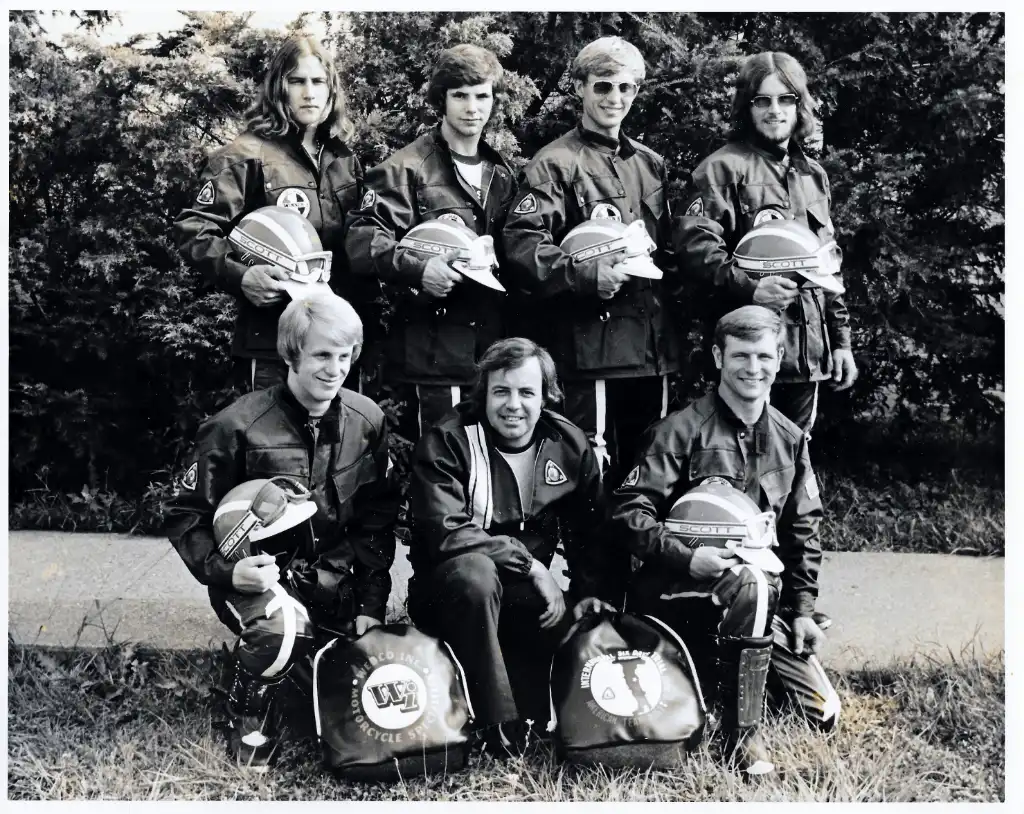
I was however given the opportunity to participate in two events. Camerino Italy in 1974 and the Isle of Mann in 1975. I was privileged to be the manager of the U.S. Trophy team on both occasions. I’m not sure to this day if I managed the team or the team managed me. I am sure of one thing, it was a great honor to be associated with, and to be considered part of a ISDT event.
I was still working at Penton Imports when I began announcing races. Like the other opportunities in my life I was at the right place at the right time. Incidentally that proves what I’ve always known. “It’s good to be good, but it’s better to be lucky.” I was at Red Bud in Michigan when the regular announcer failed to show up. Promoter Gene Ritchie asked me if I would help out. I like to talk and I knew all the riders, so why not. Besides, Gene gave me free hot dogs and all the beer I could drink.
From that first job at Red Bud, all of a sudden I was calling races every weekend. On occasion I traded my services for Hi Point advertising. In those days no one was in line to pour money into motocross, so I’d announce the race and in exchange the promoter called his event the Hi-Point National. Track announcing led to television. Lou Seals approached me and said he was going to put a motorcycle show on television and needed a host. He figured it would be easier to take a motorcyclist and teach him TV, than to take a TV guy and teach him motorcycles. At first I was skeptical and told him yeah sure. Call me when you’re ready to go. I never expected to hear from him again but to my surprise I did. And the rest is history.
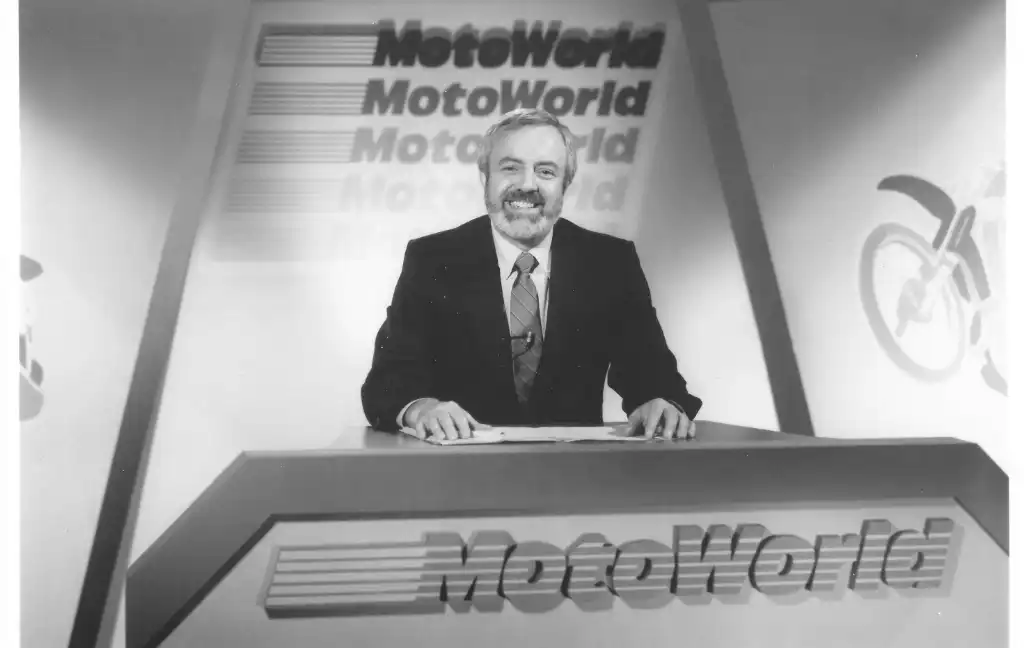
MotoWorld made its debut on the USA Network and became the first regularly scheduled motorcycle show on TV. Once a month, I flew from Ohio to Atlanta and spent the day in production. At least that’s how it was supposed to work. Problem was, one day became two. In addition to hosting the show, I ended up writing a good portion of it. I did this with John’s blessing. He thought there was some benefit to be realized from having the president of his company hosting a national television program. I don’t know about that but, I do know it was a lot of fun and it got me closer to the racing fraternity than ever before.
Eventually the show went bi-weekly and then weekly. It was decision time. I had to quit Penton or quit the show. It was a tough decision because I loved what I was doing at Penton Imports. On the other hand it was an easy decision because I was pretty sure the next call would be to replace Johnny Carson. So again I left a stable and established position to begin a new career.
Eventually I left MotoWorld in favor of doing a new show, Bike Week Magazine. Bike Week aired one hour every week on a new network, SPEEDVISION. And while it was a long way from Johnny Carson it did lead to events on live TV.
Here’s my favorite, funniest, and most embarrassing TV story. We were doing a live road race broadcast. Australian Mat Mladin winner of 6 Superbike Championships was on the pole. I had told Mat, shortly after a commercial break we would go into rider introductions beginning with him. This was nothing new since Mat usually had the pole and we had been doing this same thing for the past several races. I was positioned in front of Mat waiting for the countdown from the show's producer. I was talking to my camera man when the countdown began. When the count got to the go point I started my introduction while looking into the camera. I got to the point where I said Mat's name, turned around and stepped sideways out of the shot. I started to ask Mat a question but there was no Mat. While I fumbled for words, I saw Mat out of the corner of my eye exiting a Porta Potty that was about 20 feet away. I had to laugh as I started to apologize to the TV audience. I don’t remember what I said but I did hear loud laughing from the TV truck. Mat? He was smiling all the way from the Potty to the start line. He didn’t apologize to anyone. Just said “I had to go mate”. Obviously his need was greater than ours.
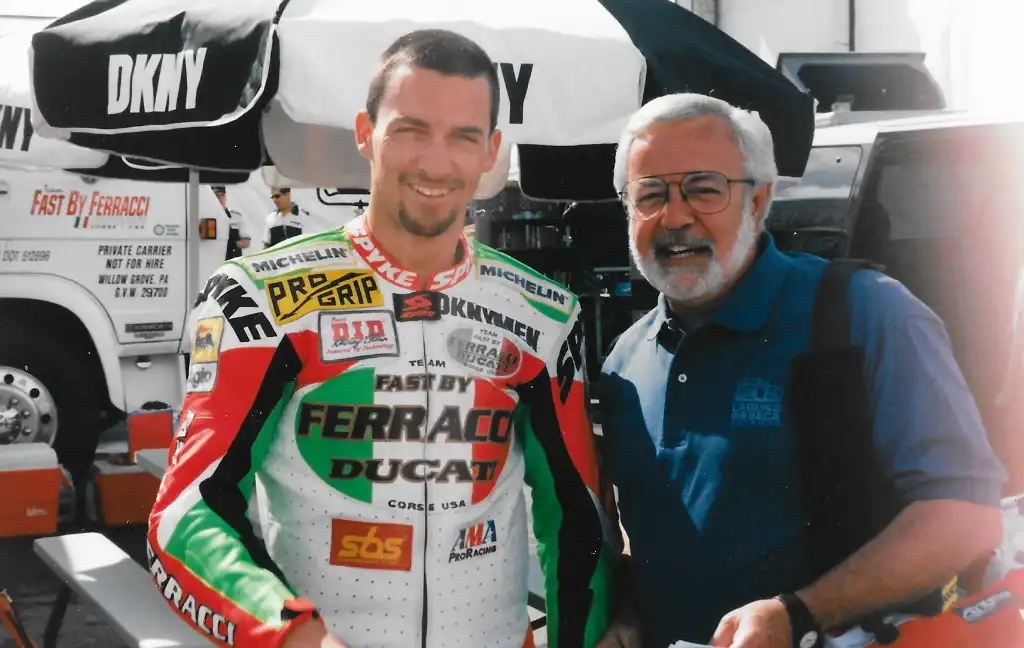
Before I wrap this up, I need to go back to my Penton Imports days and thank my fellow employees. There is no question that John Penton was and still is a man of vision, full steam ahead . We’ll worry about the consequences when we get there. But without the people assembled by John long before I got there, Penton Imports would never have been the trend setter and leader in the “Dirt Bike Off Road Revolution”.
In addition to Penton Imports there were two other branches, Penton West in Sacramento, California and Penton Central in Amarillo, Texas. In house there was an advertising and promotions company, a research and development company, a trucking company, a parts and accessories company, a full blown race team, and a Honda shop. The individuals that worked in and ran those departments of Penton Imports were a family that was not confined to the boundaries of a job description. First and foremost they flat out got the job done. To them I owe heartfelt thanks.
Also, Thanks to the members of the Penton Owners group.
Their dedication to Penton and the sport of motorcycling keeps the memories alive for old guys like me and offers a chance for the younger members to enjoy the legacy. You can’t have life without progress but I’ll tell you this. When it comes to dirt bikes, I’ll take the old days for sure. “Keep your wheels on the ground and your feet on the pegs.”


